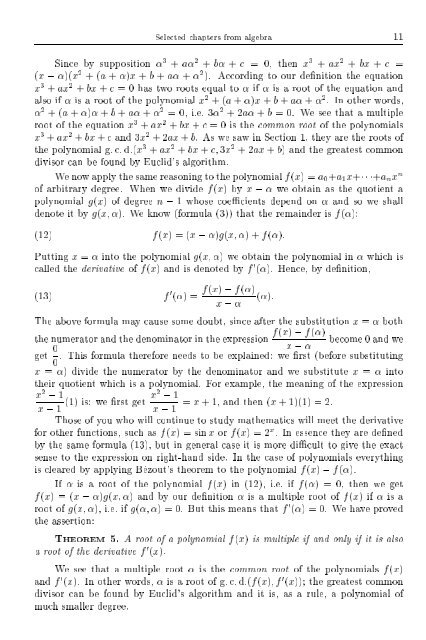SELECTED CHAPTERS FROM ALGEBRA I. R. Shafarevich Preface
SELECTED CHAPTERS FROM ALGEBRA I. R. Shafarevich Preface
SELECTED CHAPTERS FROM ALGEBRA I. R. Shafarevich Preface
Create successful ePaper yourself
Turn your PDF publications into a flip-book with our unique Google optimized e-Paper software.
Selected chapters from algebra 11Since by supposition 3 + a 2 + b + c = 0, then x 3 + ax 2 + bx + c =(x ; )(x 2 +(a + )x + b + a + 2 ). According to our denition the equationx 3 + ax 2 + bx + c =0hastwo roots equal to if is a root of the equation andalso if is a root of the polynomial x 2 +(a + )x + b + a + 2 . In other words, 2 +(a + ) + b + a + 2 =0,i.e.3 2 +2a + b =0. We see that a multipleroot of the equation x 3 + ax 2 + bx + c = 0 is the common root of the polynomialsx 3 + ax 2 + bx + c and 3x 2 +2ax + b. As we saw in Section 1, they are the roots ofthe polynomial g: c: d:(x 3 + ax 2 + bx + c 3x 2 +2ax + b) and the greatest commondivisor can be found by Euclid's algorithm.Wenow apply the same reasoning to the polynomial f(x) =a 0 +a 1 x++a n x nof arbitrary degree. When we divide f(x) by x ; we obtain as the quotient apolynomial g(x) of degree n ; 1 whose coecients depend on and so we shalldenote it by g(x ). We know (formula (3)) that the remainder is f():(12) f(x) =(x ; )g(x )+f():Putting x = into the polynomial g(x ) we obtain the polynomial in which iscalled the derivative of f(x) and is denoted by f 0 (). Hence, by denition,f(x)(13) f 0 ; f()() = ():x ; The above formula may cause some doubt, since after the substitution x = bothf(x) ; f()the numerator and the denominator in the expression become 0 and wex ; get 0 . This formula therefore needs to be explained: we rst (before substituting0x = ) divide the numerator by the denominator and we substitute x = intotheir quotient whichisapolynomial. For example, the meaning of the expressionx 2 ; 1x ; 1 (1) is: we rst get x2 ; 1= x + 1, and then (x + 1)(1) = 2.x ; 1Those of you who will continue to study mathematics will meet the derivativefor other functions, such asf(x) = sin x or f(x) =2 x . In essence they are denedby the same formula (13), but in general case it is more dicult to give the exactsense to the expression on right-hand side. In the case of polynomials everythingis cleared by applying Bezout's theorem to the polynomial f(x) ; f().If is a root of the polynomial f(x) in (12), i.e. if f() = 0, then we getf(x) =(x ; )g(x ) and by our denition is a multiple root of f(x) if is aroot of g(x ), i.e. if g( ) =0. But this means that f 0 () =0. We have provedthe assertion:THEOREM 5. Aroot of a polynomial f(x) is multiple if and only if it is alsoaroot of the derivative f 0 (x).We see that a multiple root is the common root of the polynomials f(x)and f 0 (x). In other words, isarootofg: c: d:(f(x)f 0 (x)) the greatest commondivisor can be found by Euclid's algorithm and it is, as a rule, a polynomial ofmuch smaller degree.
















